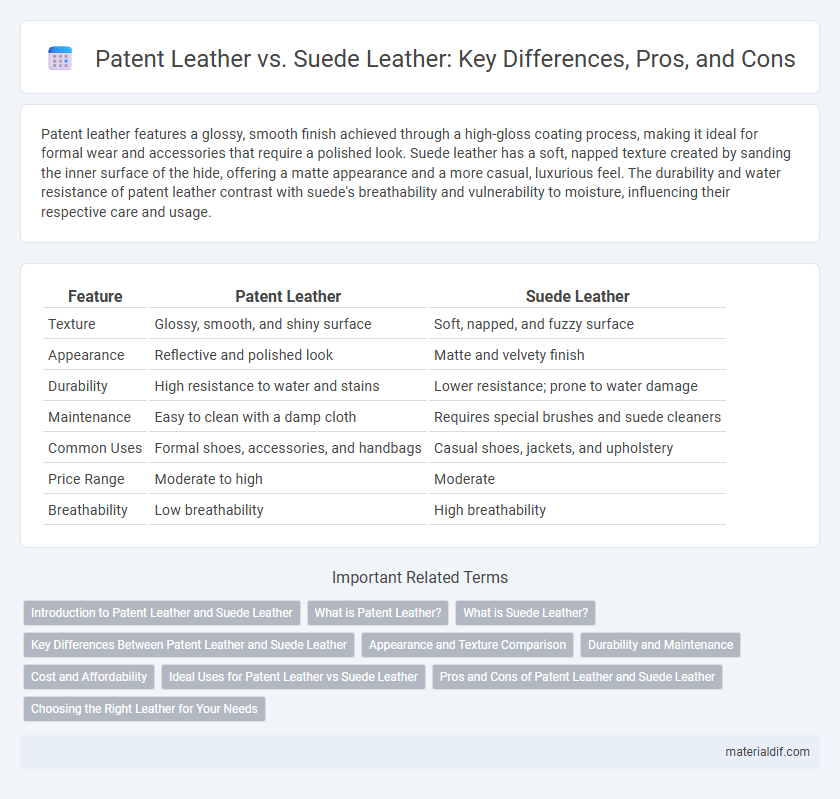Patent leather features a glossy, smooth finish achieved through a high-gloss coating process, making it ideal for formal wear and accessories that require a polished look. Suede leather has a soft, napped texture created by sanding the inner surface of the hide, offering a matte appearance and a more casual, luxurious feel. The durability and water resistance of patent leather contrast with suede's breathability and vulnerability to moisture, influencing their respective care and usage.
Table of Comparison
| Feature | Patent Leather | Suede Leather |
|---|---|---|
| Texture | Glossy, smooth, and shiny surface | Soft, napped, and fuzzy surface |
| Appearance | Reflective and polished look | Matte and velvety finish |
| Durability | High resistance to water and stains | Lower resistance; prone to water damage |
| Maintenance | Easy to clean with a damp cloth | Requires special brushes and suede cleaners |
| Common Uses | Formal shoes, accessories, and handbags | Casual shoes, jackets, and upholstery |
| Price Range | Moderate to high | Moderate |
| Breathability | Low breathability | High breathability |
Introduction to Patent Leather and Suede Leather
Patent leather features a high-gloss finish achieved through a coating process that makes it durable and water-resistant, often used in formal footwear and accessories. Suede leather is created from the underside of animal hides, producing a soft, napped texture prized for its comfort and casual style but requiring careful maintenance to avoid damage. Both types serve distinct fashion purposes, with patent leather offering a sleek, polished look and suede leather providing a matte, textured appearance.
What is Patent Leather?
Patent leather is a type of leather that features a high-gloss, shiny finish achieved through the application of a lacquer or varnish coating. This coating not only enhances the leather's appearance but also provides durability and resistance to water and stains. Commonly used in formal shoes, handbags, and accessories, patent leather offers a sleek, polished look compared to the matte, textured surface of suede leather.
What is Suede Leather?
Suede leather is a type of leather with a napped finish, created by sanding the inner surface of animal hides such as lamb, goat, or calf. It has a soft, velvety texture that differentiates it from the smooth, glossy appearance of patent leather. Suede is prized for its breathable, flexible qualities but requires careful maintenance due to its susceptibility to stains and water damage.
Key Differences Between Patent Leather and Suede Leather
Patent leather features a glossy, smooth finish achieved through a coating process that makes it durable and water-resistant, whereas suede leather has a soft, napped texture obtained from the underside of animal hide, offering a matte appearance with a delicate feel. Patent leather is commonly used in formal shoes and accessories due to its polished look, while suede is favored for casual footwear and apparel, prized for its comfort and breathability. Maintenance also differs significantly; patent leather requires simple wiping to maintain shine, whereas suede demands careful brushing and protection from moisture to preserve texture.
Appearance and Texture Comparison
Patent leather features a glossy, mirror-like finish created by applying a high-gloss coating, making it smooth and shiny to the touch. Suede leather, derived from the underside of the hide, has a soft, napped texture with a matte appearance that feels velvety and plush. While patent leather offers a sleek, reflective surface ideal for formal wear, suede provides a muted, textured look suited for casual or rugged styles.
Durability and Maintenance
Patent leather features a glossy, sealed surface that provides excellent water resistance and superior durability, making it less prone to scratches and stains compared to suede leather. Suede leather, with its soft, porous texture, is more susceptible to damage from water and dirt, requiring specialized cleaning and regular maintenance to preserve its appearance. Choosing between patent leather and suede leather largely depends on the intended use and willingness to invest time in upkeep, as patent leather offers low maintenance while suede demands careful care.
Cost and Affordability
Patent leather typically costs more than suede leather due to its glossy finish achieved through a lacquer coating process, which involves additional manufacturing steps. Suede leather, made from the underside of animal hides, is generally more affordable and offers a softer texture but requires more maintenance to prevent damage. Choosing between patent leather and suede depends on budget considerations and the desired appearance and durability for the intended use.
Ideal Uses for Patent Leather vs Suede Leather
Patent leather, known for its glossy, durable finish, is ideal for formal shoes, handbags, and accessories requiring a polished, water-resistant surface. Suede leather, with its soft, textured nap, suits casual footwear, jackets, and upholstery where comfort and a matte, tactile feel are preferred. Choosing between patent and suede leather depends on the desired aesthetic, durability, and application environment.
Pros and Cons of Patent Leather and Suede Leather
Patent leather offers a glossy, water-resistant finish that is easy to clean and maintain, making it ideal for formal wear, but it tends to crack over time and is less breathable than other types. Suede leather provides a soft, velvety texture that is comfortable and stylish for casual use, though it is more vulnerable to stains and water damage and requires careful upkeep. Both materials excel in different settings: patent leather shines in durability and shine, whereas suede stands out for its unique texture and comfort.
Choosing the Right Leather for Your Needs
Patent leather offers a glossy, durable surface ideal for formal footwear and accessories requiring water resistance and easy maintenance. Suede leather features a soft, textured finish suited for casual wear or fashion pieces prioritizing breathability and comfort, but requires careful care to avoid moisture damage. Selecting between patent and suede leather depends on your preference for style, durability, and the intended use environment.
Patent Leather vs Suede Leather Infographic

 materialdif.com
materialdif.com